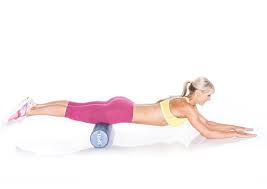
The post workout hour is the most important hour of the day….and I love what they choose to highlight…now you know why there’s breathing and stretching and dry brushing in the body care section!
The Post-Workout Window
When it comes to speeding up recovery from a ball-busting workout, no single time period may be as important as the post-workout window. After the last rep, your main focus should shift to recovery so that you can train heavier, more often, and with greater intensity. Nutrition obviously plays a crucial role, but there’s more you can do. Tapping into your parasympathetic nervous system response with specific strategies can also expedite recovery.
Do One of These Things After Training
Do at least one of the following techniques anywhere from 5-15 minutes after your last rep and you’ll come back stronger and more motivated each passing day.
1 – Self-Directed Soft Tissue Work
Though traditional self-myofascial release techniques like foam rolling play a minor role in preparing you for a workout, these techniques are a highly effective way to recover AFTER lifting. From limiting delayed onset muscle soreness to aiding in lymphatic drainage, rolling may just be the quickest and easiest way to get the recovery process going.
2 – Static and Dynamic Oscillatory Stretching
While stretching in the pre-training routine has been vilified, it still plays a minor roll in a well-designed dynamic warm-up sequence when active oscillatory stretches are prioritized over long, static-based stretching. But again, similar to foam rolling, the opposite applies to the post-training window.
After training, static stretching can be another great mechanism for recovery, especially when coupled with self-myofascial release techniques on the same tissue segments. Stretching in this window allows more of a pliable neural response to tissues due to increased amounts of blood flow and lubrication on active and adjacent joints in the kinematic chain.
3 – Deep Diaphragmatic Breathing Techniques
Just because you breathe doesn’t mean you know how to optimally breathe, especially when it comes to using your breath as a recovery mechanism. Without boring you with a patho-anatomy lesson of the respiratory tract and its response with the endocrine, musculoskeletal, and neural systems, let’s break this down. For the most part, people present with one of two different types of breathing patterns, chest breathing or belly breathing.
4 – Active Lymphatic Drainage
This may be the most simple method to speed recovery, but it’s very effective. As you train a muscle group, increased blood flow is siphoned to the area in order to continue to fuel the activity. This increased local blood flow also triggers a certain amount of fluid accumulation locally from the interstitial fluid balance, which is more commonly noticed as the prolonged pump effect of a tough workout.
Go directly to the link for the full article.
https://www.t-nation.com/training/4-things-to-do-after-lifting-to-boost-gains?utm_source=facebook&utm_medium=social&utm_campaign=article4603
Jem






